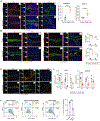Beclin-1-dependent autophagy, but not apoptosis, is critical for stem-cell-mediated endometrial programming and the establishment of pregnancy
- PMID: 37040770
- PMCID: PMC10289806
- DOI: 10.1016/j.devcel.2023.03.013
Beclin-1-dependent autophagy, but not apoptosis, is critical for stem-cell-mediated endometrial programming and the establishment of pregnancy
Abstract
The human endometrium shows a remarkable regenerative capacity that enables cyclical regeneration and remodeling throughout a woman's reproductive life. Although early postnatal uterine developmental cues direct this regeneration, the vital factors that govern early endometrial programming are largely unknown. We report that Beclin-1, an essential autophagy-associated protein, plays an integral role in uterine morphogenesis during the early postnatal period. We show that conditional depletion of Beclin-1 in the uterus triggers apoptosis and causes progressive loss of Lgr5+/Aldh1a1+ endometrial progenitor stem cells, with concomitant loss of Wnt signaling, which is crucial for stem cell renewal and epithelial gland development. Beclin-1 knockin (Becn1 KI) mice with disabled apoptosis exhibit normal uterine development. Importantly, the restoration of Beclin-1-driven autophagy, but not apoptosis, promotes normal uterine adenogenesis and morphogenesis. Together, the data suggest that Beclin-1-mediated autophagy acts as a molecular switch that governs the early uterine morphogenetic program by maintaining the endometrial progenitor stem cells.
Keywords: Beclin-1; autophagy; endometrium; morphogenesis; stem cells.
Copyright © 2023 Elsevier Inc. All rights reserved.
Conflict of interest statement
Declaration of interests The authors declare no competing interests.
Figures







References
Publication types
MeSH terms
Substances
Grants and funding
LinkOut - more resources
Full Text Sources
Molecular Biology Databases
Miscellaneous

